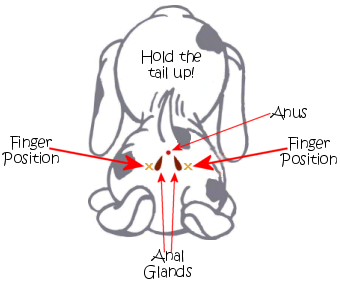Before reading this article, please:
DO NOT ATTEMP THIS PROCEDURE WITHOUT PROPER SUPERVISION FROM A QUALIFIED PROFESSIONAL AS DOING SO COULD CAUSE SERIOUS INJURY.
All dogs have anal glands. They are scent glands under the skin on each side of the dog’s anal area (at about the 4 and 8 o’clock positions). The openings to these glands lie inside the dog’s body, just inside the anus. As the dog poos, these glands are squeezed and emptied by the pressure of the poo moving past them and out of the body. If this normal emptying process doesn’t happen for whatever reason, the glands can get very full and become impacted or infected. This is quite a common source of irritation for many dogs.
Symptoms
* Sitting and dragging their bottoms along the floor, known as “scooting” (often many owners who see their dogs doing this assume it means their pet needs worming).
* Frequent and excessive licking of the perineal area
If these impacted or infected glands become quite severe or develop abscesses, the dog will be very uncomfortable indeed and may scoot, yelp, lick, and be very wary of any approach to their rear end. The dog may also exhibit signs of aggression towards his owner or, in some cases, they may show episodes of hyperexcitabililty merely due to the fact that they are so uncomfortable that they just dont know what to do with themselves.
Another cause for smelly anal glands (and boy it is smelly – in our house we refer to it as “fish-bum” because it does for all the world smell like decomposing fish) can be connected to dietary intolerances and allergies. If you can imagine eating a food you are allergic to that makes you itchy and uncomfortable, that same feeling is going to hit you as the food leaves your system through your bottom. The mucosa of the anal area is very thin, so as the stool containing the waste products your dog is allergic to passes over the mucosa, it stands to reason that it will irritate the anus and the anal glands. This in turn causes swelling, irritation and itchiness – a common cause of both the “fish-bum” smell and also the scooting behaviour when a dog drags his bottom to try to scratch the itch. The first “usual suspects” to consider from a dietary intolerance point of view would be chicken, grain or beef. If you are experiencing anal gland irritation, then perhaps an exclusion diet where you cut likely triggers out of their daily intake will help you to pin point if one of these are the culprit. Remove all three. If the problem settles, then try adding ONE of them back into their diet. If the problem flares up again, then you know they have an intolerance to that particular grain or protein. Avoid at all costs in the future.
Diagnosis
Diagnosing impacted or infected anal glands is a very straightforward procedure requiring nothing more than an internal examination by your vet. However, if the dog is very uncomfortable indeed or in an awful lot of pain, it might be necessary to sedate him to allow a full examination to take place.
Treatment
If the glands are simply full or impacted and need emptying, your vet can do this manually. This procedure although not the most pleasant thing in the world for the dog, will bring instant relief as the glands are emptied of the foul smelling substance they carry (it often comes out at quite a spurt so remember to keep your mouth shut!)
If the glands are infected or have abscesses, they will usually require treatment under anaesthetic to express the glands as it would be too painful for the dog if it were to be done awake. Once the glands are emptied, treatment for the abscess and/or infection would need to be given which might include irrigation of the gland itself as well as a course of antibiotics and painkillers.
Outlook
Simple full or impacted anal glands tend to be a recurring problem for a lot of dogs and if this is the case, it is likely to require periodic trips to the vet to have these glands emptied. Some owners are able to do this for their dog themselves, once shown how by their vet, so if this is something you feel you could do, then ask your vet to show you how.
Dogs with softer stools or frequent diarrhoea such as is seen in colitis for example may be more prone to full anal glands. Increasing the amount of fibre in the diet (eg by adding some unrefined bran or giving the dog raw vegetables) may help the glands to empty by themselves as the poo is passed – although this is my no means a fail-safe answer in all dogs.

